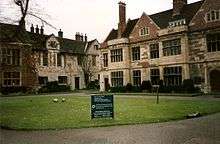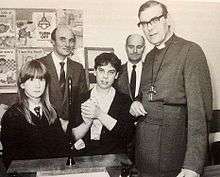Manor Church of England Academy
 | |
| Motto |
Deo Duce (Latin: "Led By God") "Serving Others, Growing Together, Living Life to the Full" |
|---|---|
| Established | 1812 |
| Type | Academy |
| Religion | Church of England |
| Principal | Simon Barber (as of September 2016) |
| Vice Principals | Michael Thunder; Simon Gumn; Indru Nariani |
| Chair of Governors | Fiona Long |
| Location |
Millfield Lane, Nether Poppleton York North Yorkshire YO26 6PA England Coordinates: 53°58′14″N 1°07′58″W / 53.97060°N 1.13268°W |
| Local authority | City of York |
| DfE URN | 121713 Tables |
| Ofsted | Reports |
| Staff | 86 (as of March 2012) |
| Students | 914 (as of March 2012) |
| Gender | Male and Female |
| Ages | 11 (Year 7)–16 (Year 11) |
| Houses | Abbey, Kings, Wentworth, Stuart |
| Website | Manor CE Academy |
Manor Church of England Academy a coeducational secondary school in York, England, and since April 2011, a Specialist Arts College and Leadership Partner School. Manor's history and traditions extend back two hundred years, over several sites in the city. Manor is part of the multi-academy trust Hope Learning Trust, York.
History
Establishment and King's Manor, 1812–1922

Manor School originated as a project by the newly formed York Diocesan Board of the National Society for the Education of the Poor, whose remit was to establish schools in each parish for the educating of the 'labouring classes', to 'render them useful and respected members of society.'[1] The first building was secured with the Merchant Taylor's Company to rent their Aldwark Hall, and on 21 May 200 boys began their first day at the newly formed school.
By 21 October, an agreement had been reached for the school to use the 'Great Room' in the historic King's Manor, as part of a plan to open a separate girls' school in Aldwark. By 1815 303 boys, 175 girls and six trainee teachers were attending the two school sites.[2]
Marygate, 1922–1942
After 110 years in the King's Manor, the accommodation was condemned, and the school moved to the former premises of York Industrial School, with the aid of a £3,800 grant from the National Society. By 1932 the school enrolled 400 senior boys. In the early hours of 29 April 1942, a Luftwaffe bombing raid on York resulted in a direct hit on the Manor School building, the headmaster arriving at 5am to find the building 'in ruins'.[3]
Priory Street, 1942–1965
Within a fortnight, the school was re-established in 'five good rooms, one not so good, two small cloakrooms and a share of the laboratory and gymnasium – very cramped quarters.'[4] The rooms were assigned to teach French, English, maths, art, and history to the 240 pupils attending. Remarkably, the school would remain in these 'ancient' quarters for more than twenty years, during the depth of Britain's post-war austerity.
Low Poppleton Lane, 1965–2009
Work started in April 1964 on a new building, the first purpose-built for the school. Overseen by Ron Dean, a young architect on his first job at Ward, Ruddick and Ward, the construction was completed in just under two years, at a cost of £133,101.[5] This was the first site for the school to have playing fields, and lessons commenced on 1 November 1965. The buildings were extended some time later, to include a new wing as the enrollment increased to around 650 pupils. In 1985 the school became a Comprehensive, a transition that would present new challenges as well as opportunities for improving the academic traditions of the school.
Millfield Lane, 2009–
Despite the 1980s extension, the 1965 building was – in later years – a cramped home for pupils and staff. A single, narrow corridor on the first and second floors of the extended wing became heavily congested between classes, and the lack of disabled access would be impossible to rectify in the existing building. In April 2009, Manor School moved to a new, highly improved site on Millfield Lane, York. The £17.6 million development now houses over three hundred more pupils then the old building, and includes facilities such as recording studios, industrial kitchens, and a central chapel for pupils. A new building, the HIVE, has been built to host Creative and Media collaborative provision for the city of York. This includes a theatre with gang plank, ticket desk and refreshments counter.[6]
In 2010 applications were advanced for Manor to receive 'Academy' status, one of only two schools in the city (and 153 nationwide) that applied for this increased independence.[7] This has led to a call in the House of Commons from York Outer MP Julian Sturdy for greater budget clarity for Academies.[8]
Headteachers

- 1812–41 – Samuel Danby
- 1841–47 – Frederick Lyne
- 1847–49 – William Pearson
- 1849–53 – Thomas Haughton
- 1853–64 – John Bird
- 1864–65 – Henry Ripley
- 1866–1910 – George Kenyon Hitchcock
- 1910–22 – George King Hitchcock
- 1922–32 – Maurice Gilbert Teesdale
- 1932–35 – G F Jackson
- 1935–43 – D H Cooper
- 1943–53 – Herbert Wroe
- 1953–68 – Norman Fieldsend
- 1968–74 – George Ranson
- 1975–81 – Marion Hodgson
- 1981–2001 – Peter Smith
- 2002–16 – Brian Crosby [9]
- 2016-present – Simon Barber
Today
Merit system
The Manor reward scheme takes the form of stickers called merits. Merits can go towards a prize draw and various certificates and awards.
Music
Manor's music performances include those of its jazz band 'Manjazz' touring Europe, winning competitions (including at a performance at the Royal Festival Hall) and fundraising in York city centre.[10] Manor School produced a pupil choir in the 1990s, an orchestra, and rock bands that competed at the York Inter-school Battle of the Bands competition, held at the York Barbican Centre.
Performing arts
As an 'Arts College' Manor school has produced shows and musicals organised by staff and pupils, including:
- Bittersweet, 2005
- Blood Brothers, 2005
- A Christmas Carol, 2005
- Little Shop of Horrors, 2006
- Pendragon, 2007
- Return to the Forbidden Planet, 2007
- Strictly Ballroom, 2008
- Disco Inferno, 2009
- Joseph and the Amazing Technicolor Dreamcoat, 2010
- Bugsy, 2011, starring David Stanton (Bugsy)
- Grease, 2012, starring Lauren Sherwood-Parrott (Sandy)
- Annie, 2013, starring Phoebe Stone (Annie), Rhys Jones (Mr Warbucks) and Amelia Knight (Miss Hannigan)
- Oliver, 2014, starring Isaac Burland (Oliver), Josh Hanham (the Artful Dodger), and Joe Armstrong (Fagin)
- Guys and Dolls, 2015, starring Lucy Simeson (Sarah Brown), Hannah Wakelam (Adelaide), Lucas Wells (Nathan Detroit) and Joe Armstrong (Sky Masterson)
The performing arts building contains a 400-seat capacity hall with sound and lighting, and a 70-seat drama studio with space for drama lessons and TV recording.[11] The HIVE is a purpose-built Creative and Media centre seating 209.[12]
Religion
As a school affiliated with the Church of England, faith and worship is often given as a reason pupils and staff choose to come to Manor. The current building has a designated space for worship and prayer, and features a cross on the building exterior, and plaques with the Lord's Prayer in each classroom. In addition, the Academy has a chaplain who attends one and a half days a week. Manor pupils attend a regular Eucharist service, for which they may travel to the nearby Holy Redeemer Church, on Boroughbridge Road.[13] The Academy website states that it does not present Church doctrine as propaganda: "It's not our purpose to take people in Year 7 and turn them into Christians by Year 11... Instead, we hope to encourage and explore ways which will enable young people to make a decision about faith."[13] The Church appoints the majority of school governors.[14]
Performance and applications
In 2012 Manor School pupils have achieved 97% 5 or more A*-C grades (equal 1st in the city) and 66% including English and Maths (the government's headline measure), ranking it 3rd in the city. The school has been regularly oversubscribed and has a selection criteria for acceptance into the school that includes the faith and church attendance of the family, siblings already attending, and proximity to the school.[15] In 2009-10 Manor was the second most over-subscribed school in the country, having to turn down many applicants for available spaces. Currently there are 180 places available for new entrants into Year 7 each year, 99 of which are allocated according to the child's stated religion.[15] Manor offers GCSEs in PE, Food, Textiles, Product Design, Art, French/German, Geography, History, Music, Dance, Drama, IT, Computing and Triple Science on top of compulsory English, Maths, Religious Studies and at least Double Science. Other courses at GCSE level with alternative qualifications are Child Development, Catering and Hospitality, Leadership, and Performing Arts. Currently, one lesson a week is set aside for 'Enrichment'; these lessons vary from singing and cooking in the lower years to careers/life skills in higher years.
References
- ↑ Crane, David; Moat, Tim; Kelly, Patrick; Evans, Richard; Wright, Tony (2012). Two Hundred Years of Manor Church of England School, York. p. 10.
- ↑ Crane 2012, p. 11
- ↑ Crane 2012, p. 24
- ↑ Crane 2012, p. 25
- ↑ Crane 2012, p. 26
- ↑ "Manor CE School pupils overwhelmed by new £17m buildings". York Press. 22 April 2009. Retrieved 7 February 2014.
- ↑ Stead, Mark (2 August 2010). "York schools' academy plans branded "regrettable"". The Press. Retrieved 7 February 2014.
- ↑ "Call for clearer academy funding". The Press. 18 October 2011. Retrieved 7 February 2014.
- ↑ Evans, Richard (1994). The History of Manor C of E School 1812–1994.
- ↑ OFSTED. "Inspection Report, Manor C of E School, 2005" (PDF). Retrieved 13 September 2012.
- ↑ "Gallery: New to the Manor". BBC Local News. Retrieved 13 September 2012.
- ↑ "About Manor C of E School, Facilities". Archived from the original on 4 September 2012. Retrieved 13 September 2012.
- 1 2 Crane 2012, p. 33
- ↑ "About MCE". Archived from the original on 4 September 2012. Retrieved 14 September 2012.
- 1 2 "ARRANGEMENTS AND POLICY FOR ADMISSION OF STUDENTS". Manor C of E School. Archived from the original on 2 May 2012. Retrieved 13 September 2012.
External links
- Diocese of York - Instrument of Government policy on electing Governors.
- Gallery: New to the Manor – BBC News photographs of the Millfield Ln building